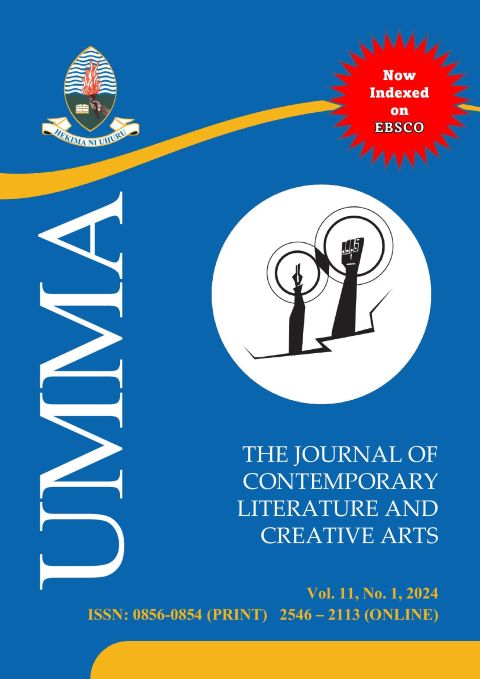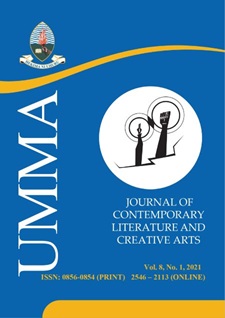Interpretation of Perlocutionary Speech Acts on Aggravation and Mitigation Circumstances: The Case of the former ICTR
Abstract
This article attempts to interpret the interactivity between force of utterance and aggravating and mitigation circumstances during the ICTR sentencing process. This process is essential in determining whether the judges’ evaluative comments aimed at addressing aggravation and mitigation circumstances are predictive of the ensuing sentences. The data for this article were accessed from the 1995–2000 Basic Documents and Case Law CD-ROM of the then International Criminal Tribunal for Rwanda (ICTR) in Arusha, Tanzania, focusing on the thirteen (13) completed cases retrievable from http://www.ictr.org. Informed by the Speech Act Theory and using Wordsmith to determine the frequency of linguistic terms at airing aggravation, the study was done on seventy-two thousand words, paying attention to interpreting the language used to address aggravating and mitigating circumstances. Findings show that emotive evaluations are not a major characteristic in sentencing, and where in use, they do not predict the harshness of punishments given.
Keywords:
Aggravation, International Criminal Tribunal for Rwanda (ICTR), Mitigation, Sentencing, and Speech Act Theory
References
References
Ashworth, A. (1983). Sentencing and the Penal Policy. London: Weidenfeld and Nicolson.
Ashworth, A. (2005). Sentencing and Criminal Justice (4th Ed). New York: Cambridge University Press.
Austin, J. (1962). How to Do Things with Words. Oxford: Clarendon Press.
Bagaric, M. (2014). "A Rational Theory of Mitigation and Aggravation in Sentencing: Why Less is More when it Comes to Punishing Criminals". Buffalo Law Review.62(5/4): 1159. Available at: https://digitalcommons.law.buffalo.edu/buffalolawreview/vol62/iss5/4.
Beresford, S. (2001). "Unshackling the Paper Tiger - the Sentencing Practices of the ad hoc International Criminal Tribunals for the Former Yugoslavia and Rwanda". International Criminal Law Review .1: 33-90.
Brown, G. & Yule, G. (1983). Discourse Analysis. Cambridge: Cambridge University Press.
Champion, D.J. (2008). Sentencing: A Reference Handbook. Oxford: ABC-CLIO.
Cheng, K.K. (2017). "Aggravating and Mitigating Factors in Context: Culture, Sentencing and Plea Mitigation in Hong Kong". New Criminal Law Review. 20(3): 506 €“533.
Clarke, D. (1983). Language and Action. Oxford: Pergamon.
Cunningham, M.D. (2010). Evaluation for Capital Sentencing. Oxford: Oxford University Press.
Danet, B. (1985). "Legal Discourse". In T. van Dijk (Ed.), Handbook of Discourse Analysis. London: Academic Press.
Faradila, R. (2013). "The Use of Illocutionary Act in Movie ' The Blind Side ' ". English Language and Literature. 2(1).
Fitzmaurice, C. & Pease, K. (1986). The Psychology of Judicial Sentencing. Manchester: Manchester University Press.
Frase, R.S. (2013). Just Sentencing: Principles and Procedures for a Workable System. Oxford: Oxford University Press.
Gibbons, J. (1994). Language and the Law. London: Longman.
Hall, M. (2016). Lived Sentence: Rethinking Sentencing, Risk and Rehabilitation. Palgrave Macmillan.
Holá, B., Smeulers, A., & Bijleveld, C. (2009). "Is ICTY Sentencing Predictable? An Empirical Analysis of ICTY Sentencing Practice". Leiden Journal of International Law. 22(1): 79-97.
International Criminal Tribunal for Rwanda, Rules of Procedure and Evidence, at Rule 101(b), 19 September 2013.
Kirchmeier, J. L. (1997). "Aggravating and Mitigating Factors: The Paradox of Today's Arbitrary and Mandatory Capital Punishment Scheme". William & Mary Bill of Rights Journal. 6(2/3), 345. https://scholarship.law.wm.edu/wmborj/vol.6/issue 2/3.
Lisnani, L., Arifin, M. B., & Ariani, S. (2017). "Illocutionary Act of Grug Utterances in the Croods Movie". Ilmu Budaya: Jurnal Bahasa, Sastra, Seni, dan Budaya. 1(2).
Martin, J. (1997). "A Balanced Performance on Sentence €“ some Comments on the Modern Role of Defense Counsel in the Sentencing Process." In M. Wasik (Ed.), The Sentencing Process. Dartmouth Publishing.
Michael, T. & Rex, S. (2002). "Reconsidering Sentencing and Punishment in England and Wales". In S, Rex and M, Tonry (Ed.), Reform and Punishment: the Future of Sentencing. Devon: William Publishing.
Nadeak, M. F., Sunggingwati, D., & Valiantien, N. M. (2017). "An Analysis of Illocutionary Act and Perlocutionary Act of Judy Hopps ' Utterances in Zootopia Movie". Ilmu Budaya: Jurnal Bahasa, Sastra, Seni, dan Budaya. 1(4): 305-316.
Pruitt, R.W. (2014). "Aggravating and Mitigating Sentencing Factors at the ICTR €”An Exploratory Analysis". International Criminal Law Review. 14:148-176. brill.com/icla.
Rankema, J. (1999). Discourse Studies (An Introductory Textbook). Amsterdam/Philadelphia: John Benjamin Publishing Company.
Roberts, J.V. (2011). Mitigation and Aggravation. New York: Cambridge University Press.
Sefriana, M. (2020). An analysis of illocutionary acts and perlocutionary acts in movie "Monte Carlo" by Thomas Bezucha (Doctoral dissertation), UIN Raden Intan Lampung.
Sloane, R. D. (2007). "Sentencing for the Crime of Crimes". Journal of International Criminal Justice. 5(3).
Stubbs, M. (1983). Discourse Analysis. Oxford: Blackwell.
Tata, C. (2002). "Accountability for the Sentencing Process". In N. Hutton & C. Tata (Eds.), Sentencing and Society: International Perspectives. Aldershot: Ashgate.
Tata, C. (2020). Sentencing: A Social Process Re-thinking Research and Policy. Glasgow: Palgrave Macmillan.
United Nations, Statute of the International Criminal Tribunal for Rwanda, at Article 23(2).
von Hirsch, A. (2011). "Foreword". In Roberts, J.V (2011) (Ed.), Mitigation and Aggravation. New York: Cambridge University Press.
Walker, N. (1969). Sentencing in a Rational Society. London: Allen Lane Penguin Press.
Wardhaugh, R. (1993). Investigating Language: Central Problems in Linguistics. Oxford: Blackwell.
Downloads
Published
Issue
Section
License
Copyright (c) 2024 CC BY-ND 4.0

This work is licensed under a Creative Commons Attribution-NoDerivatives 4.0 International License.
- Authors retain copyright and grant the journal right of first publication with the work simultaneously licensed under a Creative Commons Attribution License that allows others to share the work with an acknowledgement of the work's authorship and initial publication in this journal.
- Authors are able to enter into separate, additional contractual arrangements for the non-exclusive distribution of the journal's published version of the work (e.g., post it to an institutional repository or publish it in a book), with an acknowledgement of its initial publication in this journal.
- Authors are permitted and encouraged to post their work online (e.g., in institutional repositories or on their website) prior to and during the submission process, as it can lead to productive exchanges, as well as earlier and greater citation of published work (See The Effect of Open Access).



